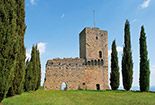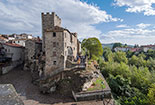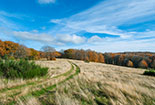VALENZANO AND POGGIO D’ACONA
in Casentino, a Tuscan valley with which you can get familiar in every detail through this site

Texts and photos by Alessandro Ferrini ©
22 accurately described images of Valenzano Castle and Poggio d’Acona. Click to enlarge
Valenzano Castle and Poggio d’Acona
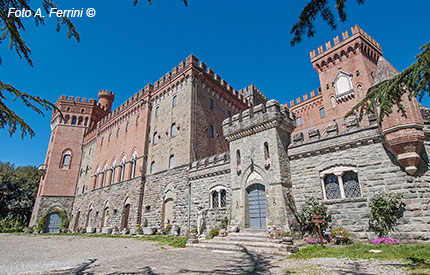 In the locality of Calbenzano, along the Regional Road 71, at about the same distance between Rassina and Subbiano, a detour leads upwards to the Castle of Valenzano and then to Poggio d’Acona. Beyond this small town, from which you have a beautiful view over the course of the Arno that comes from the upper Casentino and heads towards Arezzo, as well as the Pratomagno Massif, the road becomes narrower and tortuously descends until it crosses the road which from Rassina climbs towards Chitignano and then La Verna.
The Castello di Valenzano and Poggio d'Acona are located on the lower slopes of Alpe di Catenaia, the mountain that divides the lower Casentino from the Tuscan Valtiberina, the upper valley of the Tiber River which has its source on Mount Fumaiolo, for a few kilometers in the land of Romagna.
After visiting the austere medieval castles of the upper Casentino, in Valenzano you will find yourself immersed in something profoundly different. Poppi, Romena, Porciano reminded of the feudal period, while Valenzano makes you think of something much more romantic. And this is the right association of ideas because the castle’s project is from to the Romantic period. The origins of the castle date back to the 12th century, when the owners were the Ubertinis, lords of the whole area (the Castle of Chitignano, better known as “the Ubertini Castle” is very close and can be reached through a road that arrives to Poggio d’Acona and then continues towards Chitignano). It is hard to know the aspect and size of the castle. In 1386, the whole area passed under the dominion of the Florentine Republic. From that moment on, the castle lived a period of inevitable decline. When in the 19th century it became property of the Bastogi family, in its place there was only a pile of rubble. In 1870, the project of reconstruction was commissioned by this rich family to an architect who had followed the works of the Castle of Brolio in Chianti. This is the reason of the stylistic proximity between these two buildings. The inside of the Castle of Valenzano is characterized by a small church incorporated in the rest of the construction that overlooks an elegant courtyard. On the wall in front of it, there is a refined portico.
Today the castle is also a residence for those who want to stay in a certainly different place surrounded by woods. Environments that refer to the style of the early twentieth century. Inside the building there is also a restaurant as well as a restaurant.
Poggio d’Acona is a small town located on the ridge that separates the territory of Subbiano from that of Chitignano, both dominated by the Ubertini in medieval times. Roman coins from the first century AD found in this area testify to a very ancient history for this area.
In the locality of Calbenzano, along the Regional Road 71, at about the same distance between Rassina and Subbiano, a detour leads upwards to the Castle of Valenzano and then to Poggio d’Acona. Beyond this small town, from which you have a beautiful view over the course of the Arno that comes from the upper Casentino and heads towards Arezzo, as well as the Pratomagno Massif, the road becomes narrower and tortuously descends until it crosses the road which from Rassina climbs towards Chitignano and then La Verna.
The Castello di Valenzano and Poggio d'Acona are located on the lower slopes of Alpe di Catenaia, the mountain that divides the lower Casentino from the Tuscan Valtiberina, the upper valley of the Tiber River which has its source on Mount Fumaiolo, for a few kilometers in the land of Romagna.
After visiting the austere medieval castles of the upper Casentino, in Valenzano you will find yourself immersed in something profoundly different. Poppi, Romena, Porciano reminded of the feudal period, while Valenzano makes you think of something much more romantic. And this is the right association of ideas because the castle’s project is from to the Romantic period. The origins of the castle date back to the 12th century, when the owners were the Ubertinis, lords of the whole area (the Castle of Chitignano, better known as “the Ubertini Castle” is very close and can be reached through a road that arrives to Poggio d’Acona and then continues towards Chitignano). It is hard to know the aspect and size of the castle. In 1386, the whole area passed under the dominion of the Florentine Republic. From that moment on, the castle lived a period of inevitable decline. When in the 19th century it became property of the Bastogi family, in its place there was only a pile of rubble. In 1870, the project of reconstruction was commissioned by this rich family to an architect who had followed the works of the Castle of Brolio in Chianti. This is the reason of the stylistic proximity between these two buildings. The inside of the Castle of Valenzano is characterized by a small church incorporated in the rest of the construction that overlooks an elegant courtyard. On the wall in front of it, there is a refined portico.
Today the castle is also a residence for those who want to stay in a certainly different place surrounded by woods. Environments that refer to the style of the early twentieth century. Inside the building there is also a restaurant as well as a restaurant.
Poggio d’Acona is a small town located on the ridge that separates the territory of Subbiano from that of Chitignano, both dominated by the Ubertini in medieval times. Roman coins from the first century AD found in this area testify to a very ancient history for this area. 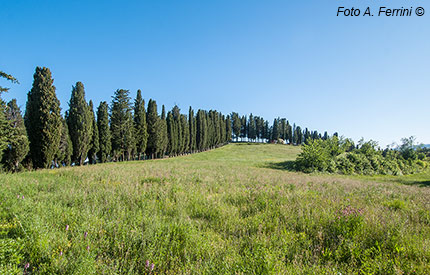 On the other hand, the toponym refers to the Etruscan culture. Today the place does not have much to show, if not, as mentioned at the beginning, a beautiful view of the valley floor and the Pratomagno on whose slopes there are small villages, including Faltona, in the Municipality of Talla, which was a castle always controlled by the Ubertini . In Poggio d’Acona there is a church built in the nineteenth century dedicated to Saint Lucia. Inside there is a painting showing this saint by Luigi Ademollo, a Milanese painter who later moved to Florence. The work was probably made in 1840, a period in which the artist was in nearby Verna having been entrusted with the restoration, only partially carried out, of the seventeenth-century paintings by Emanuele da Como that decorated the Corridors of the Stigmata.
A short distance from the town towards Chitignano, a beautiful avenue lined with cypresses that led to an important farm is worth seeing. This long line of majestic plants can be seen from many places and represents an unmistakable symbol for Poggio d’Acona.
On the other hand, the toponym refers to the Etruscan culture. Today the place does not have much to show, if not, as mentioned at the beginning, a beautiful view of the valley floor and the Pratomagno on whose slopes there are small villages, including Faltona, in the Municipality of Talla, which was a castle always controlled by the Ubertini . In Poggio d’Acona there is a church built in the nineteenth century dedicated to Saint Lucia. Inside there is a painting showing this saint by Luigi Ademollo, a Milanese painter who later moved to Florence. The work was probably made in 1840, a period in which the artist was in nearby Verna having been entrusted with the restoration, only partially carried out, of the seventeenth-century paintings by Emanuele da Como that decorated the Corridors of the Stigmata.
A short distance from the town towards Chitignano, a beautiful avenue lined with cypresses that led to an important farm is worth seeing. This long line of majestic plants can be seen from many places and represents an unmistakable symbol for Poggio d’Acona.



